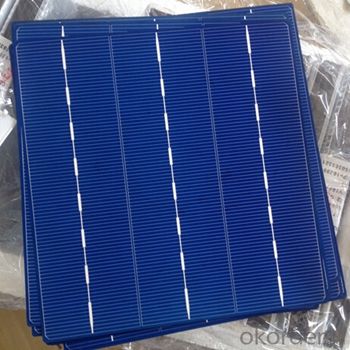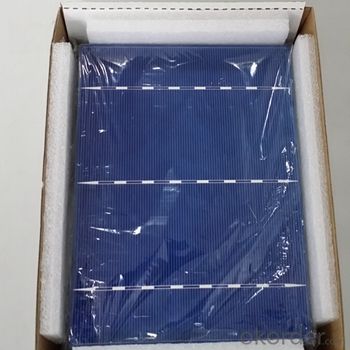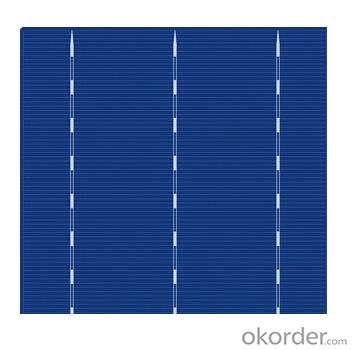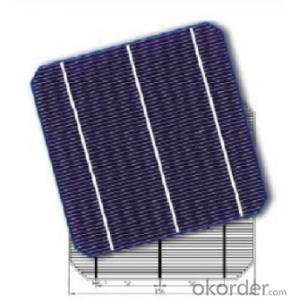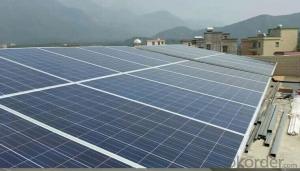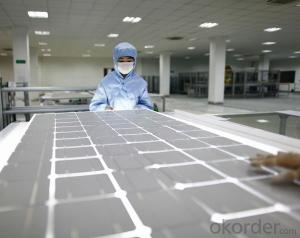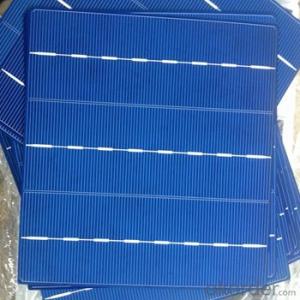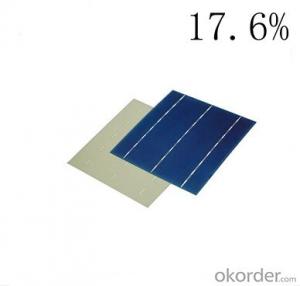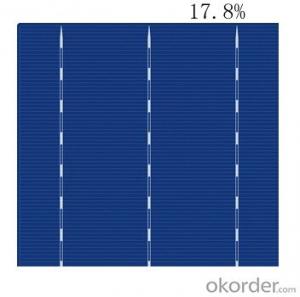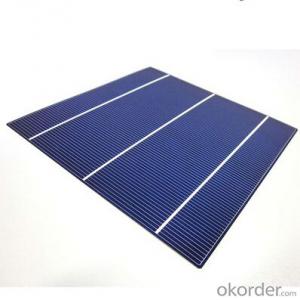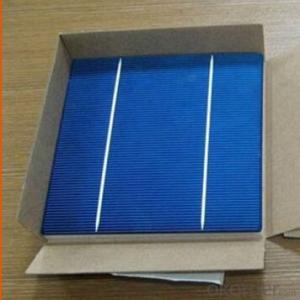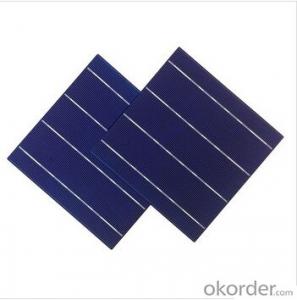Wholesale Polycrystalline Solar Cells with High Efficiency and Stable Performance
- Loading Port:
- Shanghai
- Payment Terms:
- TT or LC
- Min Order Qty:
- 5000 pc
- Supply Capability:
- 8000000 pc/month
OKorder Service Pledge
OKorder Financial Service
You Might Also Like
Polycrystalline Silicon Solar Cells:
A solar cell, is an electrical device that converts the energy of light directly into electricity by the photovoltaic effect, which is a physical and chemical phenomenon. It is a form of photoelectric cell, defined as a device whose electrical characteristics, such as current, voltage, or resistance, vary when exposed to light. Solar cells are the building blocks of photovoltaic modules, otherwise known as solar panels.
Polycrystalline Silicon Solar Cells Advantage:
• High efficiency and stable performance in photovoltaic conversion.
• Advanced diffusion technique ensuring the homogeneity of energy conversion efficiency of the cell.
• Advanced PECVD film forming, providing a dark blue silicon nitride anti-reflection film of homogenous color and attractive appearance.
• High quality metal paste for back surface and electrode, ensuring good conductivity, high pulling strength and ease of soldering.
• High precision patterning using screen printing, ensuring accurate busbar location for ease with automatic soldering a laser cutting.
Specification:
Mechanical data and design |
Format - 156 mm × 156 mm ± 0.5 mm |
Thickness- - 200 μm ± 20 μm |
Front (-) - 1.4 mm bus bars (silver),blue anti-reflection coating (silicon nitride) |
Back (+) - 2 mm wide soldering pads (silver) back surface field (aluminium) |
Temperature Coefficient of Cells |
Voc. Temp .coef.%/K -0.364%/K |
Isc . Temp .coef.%/K +0.077%/K |
Pm. Temp. coef.%/K -0.368%/K |
Electrical Characteristic |
Efficiency (%) Pmpp (W) Umpp (V) Impp (A) Voc (V) Isc (A) |
18.00% 4.380 0.538 8.141 0.634 8.740 |
17.90% 4.356 0.538 8.097 0.634 8.725 |
17.80% 4.331 0.537 8.065 0.633 8.710 |
17.70% 4.307 0.536 8.035 0.632 8.695 |
17.60% 4.283 0.535 8.006 0.631 8.680 |
17.50% 4.258 0.534 7.974 0.630 8.665 |
17.40% 4.234 0.533 7.944 0.629 8.650 |
17.30% 4.210 0.532 7.914 0.628 8.635 |
17.20% 4.185 0.531 7.88 -- 0.627 -- 8.620 |
17.10% 4.161 0.530 7.851 0.626 8.605 |
17.00% 4.137 0.529 7.820 0.625 8.590 |
Intensity Dependence |
Intensity [W/m2] Isc× [mA] Voc× [mV] Pmpp |
1000 1.00 1.000 1.00 |
900 0.90 1.000 0.90 |
800 0.80 0.99 0.80 |
500 0.50 0.96 0.49 |
300 0.30 0.93 0.29 |
200 0.20 0.92 0.19 |
IV Curve

Usage of Polycrystalline Solar Cells
Solar cells are often electrically connected and encapsulated as a module. Photovoltaic modules often have a sheet of glass on the front (sun up) side, allowing light to pass while protecting the semiconductor wafers from abrasion and impact due to wind-driven debris, rain, hail, etc. Solar cells are also usually connected in series in modules, creating an additive voltage. Connecting cells in parallel will yield a higher current; our solar cells have passed IEC Certification. With high and stable quality, our cells can greatly improve the performance of Solar Modules.
Applications of Polycrystalline Solar Cells
Assemblies of photovoltaic cells are used to make solar modules which generate electrical power from sunlight, as distinguished from a "solar module" or "solar panel". A solar array generates solar power using solar energy.
Packaging & Delivery of Polycrystalline Solar Cells
Carton Box Package and Deliver by air. It should be noticed that it should be avoid of water, sunshine and moist.
Solar Panel Images:
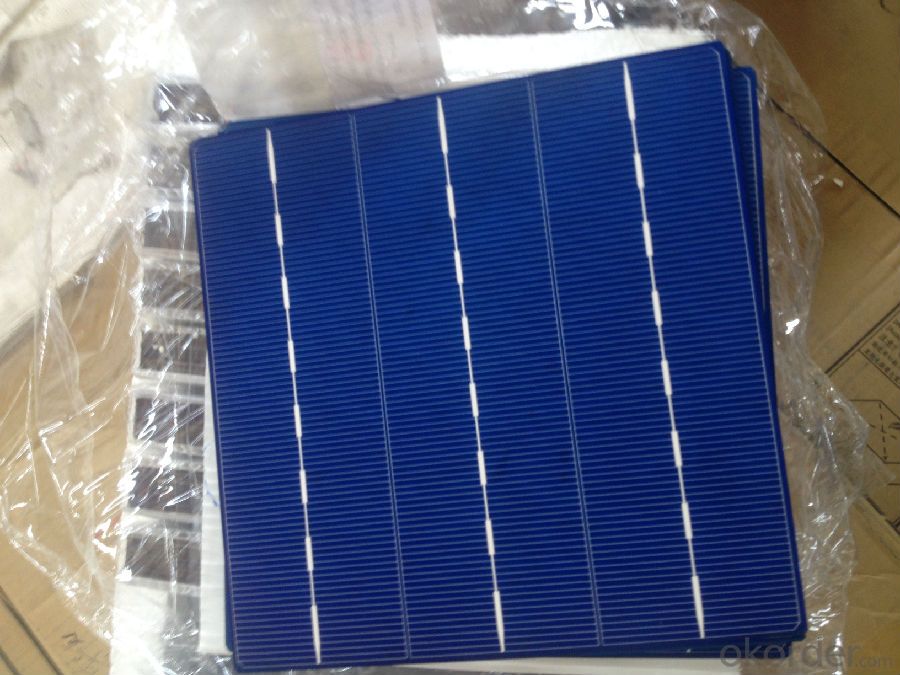
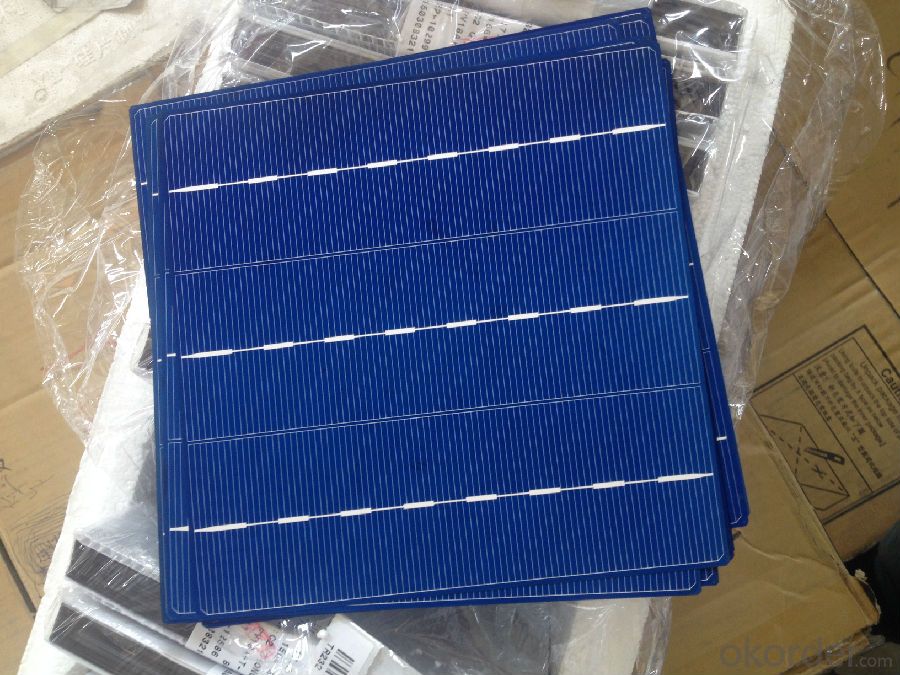
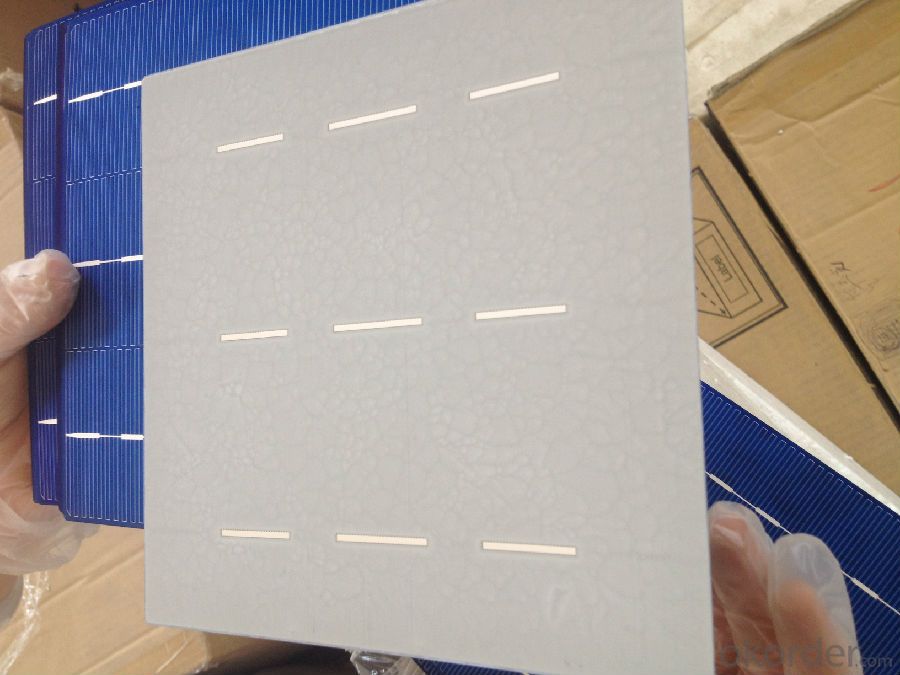
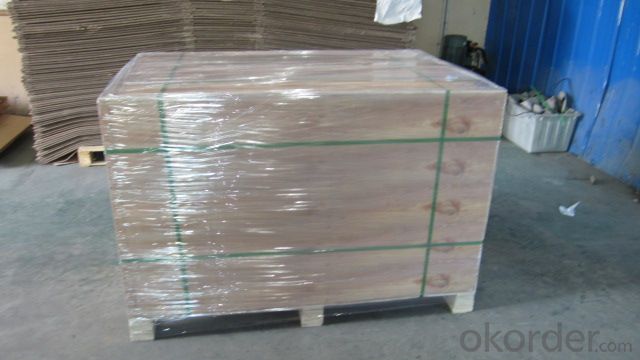
FAQ
We have organized several common questions for our clients,may help you sincerely:
①What price for each watt?
It depends on the efficiency of the solar cell, quantity, delivery date and payment terms.
②How long can we receive the product after purchase?
In the purchase of product within three working days, We will arrange the factory delivery as soon as possible. The pecific time of receiving is related to the state and position of customers.Commonly 7 to 10 working days can be served.
③Can you provide the peripheral products of the solar panels, such as the battery, controller, and inverter? If so, can you tell me how do they match each other?
Yes, we can, we have two companies for solar region, one is CNBM International, the other is CNBM engineering Co.
We can provide you not only the solar module but also the off grid solar system, we can also provide you service with on grid plant.
④What is your warranty of solar cell?
Our product can promise lower than 0.3% open box crack, we support claim after opening the box if it has crackm color difference or sth, the buyer should give pictures immediately, we can not accept the claim after the solar cell has assembled to solar panel.
• Timeliness of delivery
• ⑤How do you pack your products?
We have rich experience on how to pack the solar cell to make sure the safety on shipment, we could use wooden box or pallet as buyer's preference.
⑥ Can you do OEM for us?
Yes, we can.
Brief introduction of High Current Solar Cell
The output voltage of the high current solar cell must be calibrated high-voltage battery voltage. When the battery is fully charged, the controller disconnects the charging circuit. When the battery voltage is lower than the set voltage value, the charging circuit will re-open. Solar cells are to use light, when the charging is straight.
Slotted solar cells reduce the positive coverage, while expanding the contact electrodes, greatly improving the current collection, and thus obtain higher conversion efficiency.
Slotted solar cells due to process at the current level of processing technology and processing techniques should be relatively simple terms, it is the most suitable for large-scale industrial production, BP Spain UNSW use of technology has produced nearly a hundred since 1992 MW BCSC batteries, the main problem is to solve the industrialization process route design, and strict quality control of the production process.
Among the many aspects to consider in order slotting process and metallization process is most important, not only to the quality of the battery and cell conversion efficiency, but also a very strong impact on industrial productivity. Slotting process a variety of styles, laser, mechanical grooving, chemical corrosion, physical groove, etc., which have a mature technology; we can meet the design requirements. In particular it should be noted that the groove is formed BC battery key, groove, physical dimensions and surface state will very strongly affect battery performance parameters, in addition to metalization BC battery is a very important part, should arouse a high degree of seriously.
BCSC for monocrystalline silicon single-crystal silicon, should use high quality Cz silicon, should try to reduce the oxygen, and carbon content of heavy metal impurities, special emphasis is to select few defects, in order to ensure a higher wafer carrier lifetime.
- Q: How can I explain to my 10 year old daughter what solar cells are?
- Solar cells are the cell that can collect the solar energy from nature.
- Q: Can solar cells be used in remote monitoring systems?
- Yes, solar cells can be used in remote monitoring systems. Solar cells are an efficient and sustainable source of energy, making them ideal for remote locations where access to electricity may be limited or non-existent. By harnessing sunlight, solar cells can power remote monitoring systems, enabling continuous data collection and communication in these areas.
- Q: What is the role of solar cells in powering remote surveillance systems?
- Solar cells play a crucial role in powering remote surveillance systems by converting sunlight into electrical energy. They provide a reliable and sustainable source of power, eliminating the need for traditional electrical infrastructure in remote locations. This enables continuous operation of surveillance cameras, sensors, and other equipment, ensuring effective monitoring and security even in areas without access to the grid.
- Q: On the parallel connection of solar cells
- As for the solar cells in the string, parallel combination is Causing the damage of the battery pack, I think it is first necessary to make sure that the "combined" solar cells should have the same characteristics, and that the various parameters between them should be the same or similar, at least several major parameters must be the same, to achieve these Conditions can be combined after the combination; if the series combination in the use of a group of solar cells damaged and broken, then the other groups will not power the power supply equipment, because the entire line has been in the open state,
- Q: What are the advantages of monocrystalline silicon and polycrystalline silicon in solar power?
- single The wafer hot process time can be completed in less than one minute, using the process to make a cell conversion efficiency of more than 14% on 100 square centimeters of polysilicon wafers. It is reported that the current 50 ~ 60 micron polysilicon substrate produced on the battery efficiency of more than 16%. The use of mechanical groove, screen printing technology in the 100 square centimeter polycrystalline efficiency of more than 17%,
- Q: How do solar cells perform in areas with high levels of noise pollution?
- Solar cells are not affected by noise pollution as it has no impact on their performance. Noise pollution does not interfere with the ability of solar cells to convert sunlight into electricity, making them a reliable energy source even in areas with high levels of noise pollution.
- Q: I would like to use a ppt to show how solar cells can work in a power generation factory, can anybody share some useful information with me?
- For a ppt, I think you should start with the definition of solar cells to give a basic introduction of solar cells.
- Q: What is the impact of solar cell installations on property values?
- The impact of solar cell installations on property values is generally positive. Studies have shown that homes with solar panels tend to sell for higher prices and have faster selling times compared to similar homes without solar installations. Solar energy is becoming increasingly popular and homeowners recognize the financial benefits of reduced energy costs and potential tax incentives. Additionally, solar installations contribute to a more sustainable future, which is an attractive quality for many buyers.
- Q: Can the solar powered cells really work better than the normal cells?
- Yes, of course, the solar powered cells are much better than the normal cells, not only it functions better but also because it can save much more ebergy while proving more energy.
- Q: Can solar cells be used for powering remote military installations?
- Yes, solar cells can be effectively used for powering remote military installations. Solar power offers a reliable and sustainable energy solution for such locations, reducing dependence on traditional fuel sources and minimizing logistical challenges. The advancements in solar technology have made it possible to generate sufficient power even in remote areas, ensuring continuous and independent energy supply for various military operations and equipment.
Send your message to us
Wholesale Polycrystalline Solar Cells with High Efficiency and Stable Performance
- Loading Port:
- Shanghai
- Payment Terms:
- TT or LC
- Min Order Qty:
- 5000 pc
- Supply Capability:
- 8000000 pc/month
OKorder Service Pledge
OKorder Financial Service
Similar products
Hot products
Hot Searches
Related keywords



